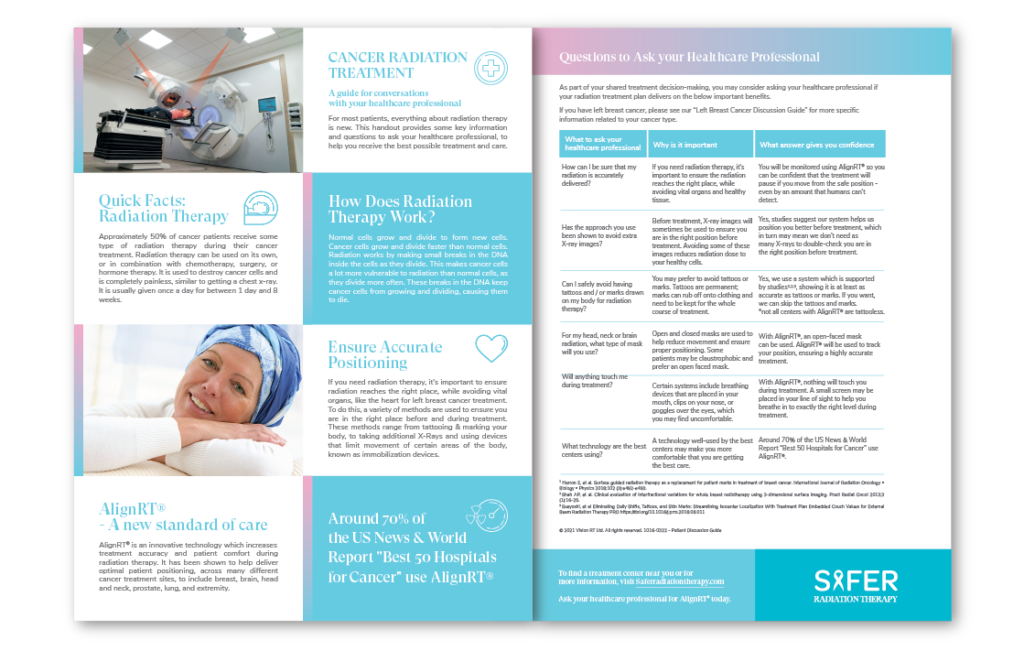General Patient Discussion Guide
A guide for conversations with your healthcare professional
For most patients, everything about radiation therapy is new. This handout provides some key information and questions to ask your healthcare professional, to help you receive the best possible treatment and care.
Please feel free to download this information to take with you to your next doctor’s appointment.
Approximately 50% of cancer patients receive some type of radiation therapy during their cancer treatment. Radiation therapy can be used on its own, or in combination with chemotherapy, surgery, or hormone therapy. It is used to destroy cancer cells and is completely painless, similar to getting a chest x-ray. It is usually given once a day for between 1 day and 8 weeks.
Quick Facts: Radiation Therapy
If you need radiation therapy, it’s important to ensure radiation reaches the right place, while avoiding vital organs, like the heart for left breast cancer treatment. To do this, a variety of methods are used to ensure you are in the right place before and during treatment. These methods range from tattooing & marking your body, to taking additional X-Rays and using devices that limit movement of certain areas of the body, known as immobilization devices.
Ensure Accurate Positioning
Normal cells grow and divide to form new cells. Cancer cells grow and divide faster than normal cells. Radiation works by making small breaks in the DNA inside the cells as they divide. This makes cancer cells a lot more vulnerable to radiation than normal cells, as they divide more often. These breaks in the DNA keep cancer cells from growing and dividing, causing them to die.
How Does Radiation Therapy Work?
AlignRT® is an innovative technology which increases treatment accuracy and patient comfort during radiation therapy. It has been shown to help deliver optimal patient positioning, across many different cancer treatment sites, to include breast, brain, head and neck, prostate, lung, and extremity
AlignRT® + DIBH - A new standard of care
Questions to Ask your Healthcare Professional
How can I be sure that my radiation is accurately delivered?
Why is this important:
- If you need radiation therapy, it’s important to ensure the radiation reaches the right place, while avoiding vital organs and healthy tissue.
What answer would give you confidence:
- You will be monitored using AlignRT® so you can be confident that the treatment will pause if you move from the safe position – even by an amount that humans can’t detect.
Has the approach you use been shown to avoid extra X-ray images?
Why is this important:
- Before treatment, X-ray images will sometimes be used to ensure you are in the right position before treatment. Avoiding some of these images reduces radiation dose to your healthy cells.
What answer would give you confidence:
- Yes, studies suggest our system helps us position you better before treatment, which in turn may mean we don’t need as many X-rays to double-check you are in the right position before treatment.
For my head, neck or brain radiation, what type of mask will you use?
Why is this important:
- Open and closed masks are used to help reduce movement and ensure proper positioning. Some patients may be claustrophobic and prefer an open faced mask.
What answer would give you confidence:
- With AlignRT®, an open-faced mask can be used. AlignRT® will be used to track your position, ensuring a highly accurate treatment.
Can I safely avoid having tattoos and / or marks drawn on my body for radiation therapy?
Why is this important:
- You may prefer to avoid tattoos or marks. Tattoos are permanent; marks can rub off onto clothing and need to be kept for the whole course of treatment.
What answer would give you confidence:
- Yes, we use a system which is supported by studies 1,2,3, showing it is at least as accurate as tattoos or marks. If you want, we can skip the tattoos and marks. *not all centers with AlignRT® are tattooless.
Will anything touch me during treatment?
Why is this important:
- Certain systems include breathing devices that are placed in your mouth, clips on your nose, or goggles over the eyes, which you may find uncomfortable.
What answer would give you confidence:
- With AlignRT®, nothing will touch you during treatment. A small screen may be placed in your line of sight to help you breathe in to exactly the right level during treatment.
What technology are the best centers using?
Why is this important:
- A technology well-used by the best centers may make you more comfortable that you are getting the best care.
What answer would give you confidence:
Download the Discussion Guide
A helpful resource for your conversations with your healthcare professional.
1 Herron E, et al. Surface guided radiation therapy as a replacement for patient marks in treatment of breast cancer. International Journal of Radiation Oncology • Biology • Physics 2018;102 (3):e492-e493.
2 Shah AP, et al. Clinical evaluation of interfractional variations for whole breast radiotherapy using 3-dimensional surface imaging. Pract Radiat Oncol 2013;3 (1):16-25.
3 Sueyoshi, et al Eliminating Daily Shifts, Tattoos, and Skin Marks: Streamlining Isocenter Localization With Treatment Plan Embedded Couch Values for External Beam Radiation Therapy PRO https://doi.org/10.1016/j.prro.2018.08.011

